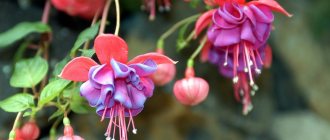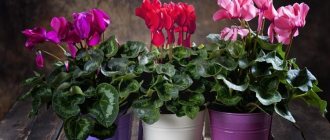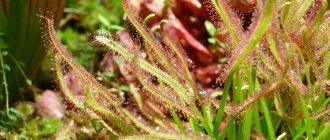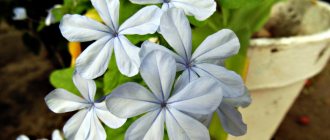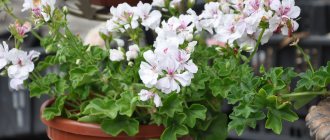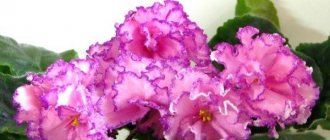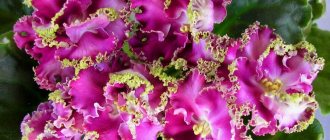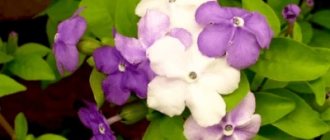Among indoor vines there are many original and even exotic plants. But hardly anyone is able to compete in their “peculiarity” with dyschidia. This is a unique, very graceful epiphytic plant, in which, in addition to charming small main leaves, water-storing “bubbles” are also formed. Delicate shades of green and the brightest scarlet or pink color of miniature flowers, flexibility of shoots and elegance make dischidia a real legend. And although it is not easy to grow, how much joy and pleasure it brings afterwards!
Dischidia ruscifolia. © WoS
Botanical description
In the wild, dischidia grows in the tropics of East Asia, Africa, and America. Some species are cultivated for growing in temperate climates as houseplants. It is part of the large Lastovniev family, close to the sister genus Hoya, but unlike it, it has not been fully studied. About 120 species of flower are known, but only a small part is grown at home.
Dischidia is considered a representative of an epiphytic culture, capable of crawling along supports due to whitish adventitious roots. The height of the compact form of the vine reaches from 0.5 to 1.0 meters. It is possible to achieve a specific size if you practice different methods of tying and growing forms.
Curly and flexible shoots are framed by several types of leaf plates. Some of them are small in the form of an ellipse, pointed at the end, similar to a heart, others are larger in size, fleshy with the ability to fuse the ends in such a way that double jug-shaped or spherical balloons 5 cm long are obtained.
Against the background of a green waterfall of foliage, from spring to autumn, small flowers bloom in the axils, collected in whorls of 3-4 pieces. This usually happens 1-2 times a year. After flowering, pods with seeds are formed.
The foliage stores a supply of water in case of drought. In nature, ants settle in them and drag plant debris here. Moisture promotes rotting of the accumulations, which turn into a nutrient substrate. Over time, aerial roots penetrate into moisture storage containers and receive nutrition. The plant has retained this genetic feature of a subtropical crop - it can independently regulate the level of humidity, which saves it from death in the absence of water.
Each dischidia seed is as volatile as a dandelion and requires caution when working, as it is easily lost.
Features of care
Dyschidia care at home requires painstaking attention to a special temperature regime.
Temperature
Dischidia is a heat-loving flower. The room where it grows should not be colder than 18 °C. Temperature maximum - 30 °C. The ideal range would be 22-25 °C.
Lighting
The lighting should be good. In this case, the light should not be direct. Tender leaves are susceptible to burns when exposed to sunlight.
Important! Northern window sills without artificial lighting are contraindicated. It can be placed on the south only if it is possible to slightly shade the glass
Rooms on the east or west side of the house work well.
Watering
Moderate watering is required, but the soil should not dry out completely. In summer, water weekly when the top layer of soil dries. In winter, watering is reduced to once a month.
Take water:
- filtered;
- boiled;
- stood for at least 3 days;
- rain;
- from melted snow.
Important! Hard tap water, not prepared in the above way, can destroy the succulent
Spraying
Spraying from a spray bottle is carried out regularly with the same soft water as for irrigation. In summer and during the heating season it is necessary to spray at least once a day.
Humidity
The higher it is, the better. Minimum - 40%. Provided in the following ways:
- using an automatic humidifier;
- placing a pot with dischidia on a pallet covered with pebbles, expanded clay, etc.
- frequent spraying.
Note! To monitor the degree of air humidity, you can purchase and install special sensors. But an ordinary weather station will do a good job of determining the humidity level
Priming
The soil should be breathable and well saturated with water. Heavy clay soil is not suitable. Ready-made soil mixture can be purchased at a botanical store. A mixture for orchids is suitable. Experienced gardeners can independently prepare the substrate for planting dischidia. It should include:
- peat moss (sphagnum) - one part;
- peat - three parts;
- sheet soil - two parts.
- some river sand and charcoal.
Important! The drainage layer at the bottom of the flowerpot should not be less than 2 cm, this will ensure the outflow of excess water
Feeding
For feeding, choose fertilizers for succulents or decorative foliage plants. Fertilize no more than once a month during the active growing season. Alternate soil (watering) and foliar (spraying) fertilizing.
Ovoid
Ovate (Ovata) is a hanging plant that is unpretentious in cultivation and can withstand drafts. Flower growers note that when an ovoid dischidia is placed in the coldest place under a window, the active period of budding begins and Ovata will soon bloom.
When open, the flowers in different shades of pink and orange reach a diameter of 2.5 cm. This variety is characterized by a greenish-pink color of elongated long stems with neat oval-shaped leaves, on which white veins are clearly visible. The leaf blades are velvety and slightly wavy to the touch.
You can see what the Dischidia Ovate variety looks like in the photo below:
Dischidia Ovate Ovata
Types of dyschidia
About 7 species of dischidia are classified as ornamental plants, although the number of their varieties in nature is measured in several dozen. Only two subspecies of dischidia have spread in indoor culture:
- Vidal's dischidia (Dischidia vidalii), better known by our old name Dischidia pectenoides) is an elegant vine with main leaves of a uniform light green color and additional water-storing bubble-shaped leaves;
- Dischidia ovata - with dense, perfectly oval leaves with an elongated tip, on the surface of which longitudinal light veins appear.
Dischidia ruscifolia, a dischidia with pointed leaves, as well as large dense inflorescences of large dischidia (Dischidia major) are considered very rare
Dischidia ovata
Vidal's dischidia (Dischidia vidalii). © CHERRY ONG
Nummularia
Nummularia (Pangolin kisses) will not leave anyone indifferent. Most often it is grown in hanging containers, where it looks very attractive due to its thick climbing shoots up to 1.5 meters long, densely strewn with light green, round, plump leaves up to 1 cm in diameter.
The leaves are similar to coins, which is why the second name of the variety is coin. Due to its unusual exotic appearance, other translations of the name of the plant are known - dragon's kiss, lizard's kiss.
In almost every leaf node along the entire length of the shoot axillary inflorescences are formed, blooming with small white flowers.
Nummularia differs from its relatives in its slow growth, so if you want to see the beauty of the variety faster, it is better to purchase adult specimens.
It is worth noting that this variety is not cheap, and after purchasing it you will have to arrange “dances” near the bush in order to please the capricious vine by strictly observing the conditions of maintenance.
In the photo below is the variety Dischidia Nummularia:
Dischidia Nummularia
General information:
Diascia
- a low-growing plant with a straight or creeping stem, small sessile serrated leaves having an ovoid or elliptical shape. In nature it grows up to one meter, in the garden it reaches a height of sixty centimeters. It has individual branches that trail along the ground or hang from a hanging container.
The Diascia flower reaches a diameter of no more than twenty millimeters; its appearance is similar to the snapdragon flower. The perianth is tubular, has five lobes, the upper two have spurs, the three below are large, the so-called lower lip is formed. The multiple flowers are pink, orange, salmon, purple and remain on the stem for a long time.
The genus Diascia has more than fifty species, some of them are annual plants that grow in lowland parts of the natural environment, others, representatives of the mountainous region, are perennials. The latter species is common in Europe as an ornamental plant.
Ease of propagation, rapid development and abundant long flowering have made Diascia a popular annual. The numerous drooping stems dotted with flowers are especially impressive when grown in pots and containers. It blooms in waves, the first flowering lasts a month from the beginning of summer, then after pruning, the bush blooms again until mid-autumn.
Ruskusolistnaya
The length of the shoots varies from 50 cm to one and a half meters. A characteristic feature is the similarity of the variegated fleshy leaves with hearts, for which the plant is lovingly called a million hearts. Flowering lasts all year round with white or pink-white flowers from which a honey aroma emanates. Requires high humidity and heat for rapid growth. Young specimens feel better in a greenhouse or under a hood.
Dischidea is ready to put up with the dry air for a while, but the roots cannot tolerate the bay after it dries out and begin to rot.
The photo below shows Dischidia Ruscusifolia:
Dischidia Ruscusolifolia
Irrigation system
The plant is quite demanding when it comes to watering because it needs a stable level of soil moisture. Moisten the substrate provided that it has dried to a depth of 2-3 cm.
Excessively dry soil should not be allowed, but the plant will be able to adapt, but waterlogging will lead to death. Water no more than 2-3 times monthly. In winter, the soil should be moistened twice as often - once every 3 weeks.
Dischidia is watered with soft water. Requires liquid at room temperature. It is advisable to take it after boiling or filtered.
A million hearts
Overall, Million Hearts performs well due to its heart-shaped leaves and delicate white bell-shaped flowers. Doesn't like being moved to another place during flowering. The flowers immediately dry out and only a few remain on the stem. It differs from ruscusolifolia in the color of the foliage; this variety has a bright green color. At the slightest deviation from the conditions of maintenance, the trunk dries out, the foliage begins to wrinkle and fade. Spraying with soft water and alternating fertilizer for orchids in low concentration stimulates growth and flowering.
Dischidia Million Hearts
Top dressing
This must be done carefully - two fertilizings per year using fertilizer diluted by 50% is enough. It is recommended to fertilize in mid-spring and summer.
Some experts prefer to apply fertilizer in small portions monthly in the spring and summer. Fertilizers for succulents are preferred. It is advisable to take turns doing standard feeding and foliar feeding.
Grebeshkovaya
When grown on a support, it is possible to create a living green wall due to the large number of aerial roots, which looks very picturesque in the interior of the room. The climbing epiphytic plant has original comb-like foliage and amazing blooms of purple pitcher flowers. When watering a flower you need to be restrained. The substrate should be moist, but not swampy. When there is a lack of light, dischidia sheds its leaves, so in winter you need to take care of artificially illuminating the bushes.
Dischidia Grebeshkovaya
Conditions of detention
Lighting
Although in nature the crop can grow in the shade, indoors it is better to place it in the light. However, it is worth remembering that the plant does not tolerate direct sunlight. Lighting should be diffused.
An excellent option is an east or west window. The south windows are darkening. As for the north side, lighting is required here. The culture develops well under artificial light.
Appleleaf
The name of the variety is associated with the similarity of the leaf blades to apple leaves, which are as large and round as the fruit. On the surface of the dark green leaves, a scattering of white inclusions is visible, which resembles marble. It has a negative attitude towards direct sunlight, because of which burns appear on the leaf plates. It is possible to grow in a florarium under artificial lighting. For normal development, you need to ensure that the humidity does not drop below 50%.
The ideal place for growing is the bathroom if the room has windows with western or eastern orientation. In this place, all the dischidia needs is warmth and humidity.
Dischidia Applefolia
Common problems
Problems arise from improper care. If the air is dry, spider mites and aphids may appear. When the soil is waterlogged, the root system and shoots will begin to rot.
If the air humidity is very low, then the bubble bags will be without water, and this leads to an imbalance. Also, low humidity will cause the leaves to deform and the tendrils will become dark. When red dots are found on the leaves, this means sunburn.
Such a plant is the dischidia liana. It is difficult to grow, but those who already keep it are simply fascinated by this beautiful, unusual and such a spectacular flower.
In another article we described: Croton: propagation and care at home
Vidalia
Two or three times a year you can observe Vidalia dischidia blooming with soft pink flowers against a background of bright green foliage. You should not be overzealous with lighting, since if there is too much light, the round leaves turn reddish, which reduces the decorative value of the bushes. Prefers a modest dose of fertilizer for foliage crops and succulents, which is applied at the root or added to warm water for spraying.
Dischidia Vidalia
Diseases and pests
Among the diseases, the plant is susceptible to root rot, which develops when the soil becomes waterlogged as a result of improper watering. Root rot leads to the withering of the crop and its death. You can save a diseased plant by replanting it in a fresh substrate and a new pot with preliminary pruning of the affected roots and treating them with a solution of potassium permanganate.
Dyschidia can also be attacked by pests such as mealybugs and spider mites. To destroy them, the plant must be treated with the Actellik insecticide according to the instructions on the package with the drug.
Khirsuta
in the collections of flower growers . The leaves are round in shape with dense pubescence, pointed at the ends, and a relief pattern is clearly visible on the surface. Produces buds of a wonderful wine color. More often they are grown in hanging containers, from which stems up to one and a half meters long hang down. Throughout the year, you should not drop the temperature below 18 degrees Celsius.
Dischidia Hirsut
Transfer
It is necessary to use an orchid or bromeliad substrate as soil. The soil should be loose and fibrous. It is permissible to mix leaf soil or peat mass with sand and sphagnum in a ratio of 2:1:3.
If the flower will grow in a florarium, then it is advisable to take a mixture of crushed pine bark and sphagnum in a 2:1 ratio. Adding charcoal won't hurt.
The flower is replanted in the spring, when signs of growth in the active phase are visible. Only young dischidia are suitable for regular replanting every year if their roots have filled the pot. A drainage pad should be placed at the bottom. The plant is also grown on driftwood.
Reproduction
Seeds
This is a labor-intensive and troublesome method that requires care when sowing, since volatile seeds are easy to lose. It is advisable to use freshly harvested seed material with high germination rate. Suitable soil for seed propagation from leaf soil and peat. Add 2 parts of perlite to the mixture.
Step-by-step instruction:
Before sowing, the seeds are processed, removing fluff.- Moisten the soil, lay it loosely on top of it, without deepening the dischidia seeds.
- Sprinkle with a thin layer of soil, no more than 5 mm.
- Create greenhouse conditions by covering with a film or glass cap. Regularly ventilate and moisten with a spray bottle.
- Shoots appear by the end of the first ten days, but you should not disturb them, but wait until the first true leaves appear. then dived into separate containers.
Seedlings are kept at a temperature of 20-25 degrees Celsius in bright light without direct sunlight.
Cuttings
It is considered a simple method of propagation that is suitable for beginners.
Cuttings 8-10 cm long are cut at an angle from the upper parts of the shoots, not forgetting to sprinkle the cut areas with charcoal.
Cuttings are treated with Kornevin.
Due to the fact that there are many aerial roots on them with sufficient moisture in the soil mixture of peat and sand, covered with plastic film, rooting occurs within three weeks.
The greenhouse should be regularly ventilated and moistened and the temperature maintained at +20-25°C.
Some gardeners practice rooting cuttings in sphagnum moss in a tightly closed plastic cake box. You must remember to regularly ventilate and moisten the moss.
Planting material can be taken from leaf balloons - moisture accumulators. Under favorable conditions, daughter plants develop in them. To obtain them, the leaf plate is carefully cut with a sharp blade, the sprout is removed from there and planted in a permanent place in a suitable container. No pre-processing required.
Air humidity
The most stringent requirements are imposed on the characteristics of the air - its high humidity, and therefore the best conditions are created in terrariums for plants. But growing it as an ampelous plant or a vine with a support is quite achievable.
It is important to provide comfortably humid conditions - dischidia can be sprayed. It is resistant to getting wet. Pallets with wet pebbles or moss are perfectly acceptable. You can also install special humidifiers. Stable humidity levels of 40-50% will be optimal.
